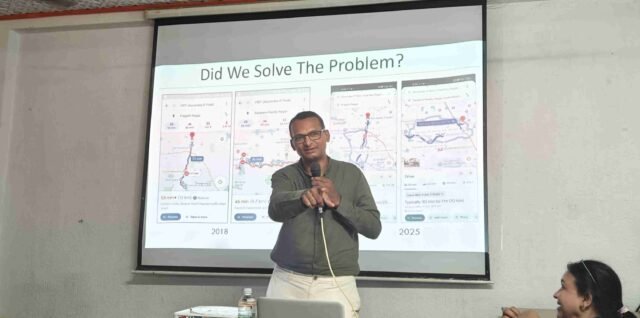Hyderabad: Hyderabad is on the verge of a mobility breakdown, warned urban transport specialist Prasanth Kumar Bachu, citing decades of policy failure, the decline of public transport and an unchecked rise in private vehicle use.
As the city continues to sprawl beyond its traditional limits, its transport systems are failing to keep pace, placing both infrastructure and citizens under pressure.
“Hyderabad is a textbook case of political attention to roads and flyovers, without addressing the systems that govern how people actually move,” said Bachu.
Centralised work, decentralised impact
The continued concentration of major employment hubs in areas like Hitech City and Gachibowli has forced lakhs of Hyderabadis into long, daily commutes.
While urban planners have long championed mixed-use development, implementation remains poor. “In Western countries, people shift homes for work. Here, emotional and cultural ties keep people rooted. That’s a unique planning challenge,” said the expert.
Public transport is in sharp decline
Despite a population of over 1.2 crore, Hyderabad now operates just 2,000 TGSRTC buses, down from 3,400 in 2011. The Hyderabad Metro, meanwhile, caters to only 5 lakh passengers daily. “A 40 per cent drop in bus services while the city expands is alarming. This isn’t neglect, it’s active disinvestment,” Bachu asserted.
Private vehicles: Policy favours, public cost
Thanks to manufacturing incentives, car prices remain low despite inflation.
Meanwhile, bus fares have risen, making public transport less affordable for daily commuters. “A car that should now cost Rs 30 lakh is still sold at Rs 10 lakh. But bus fares have doubled or tripled. That’s not progress, that’s regression,” he noted.
Corporate culture fuels the gridlock
Hyderabad’s corporate sector, especially in IT corridors, offers free parking spaces (up to 1,050 sq. ft. per car) to employees while offering no similar support for public transit users. “Why give car subsidies but not bus incentives? Hitech City should run a pilot to reverse this logic,” he suggested.
Electric vehicles: Not the final answer
While EVs may reduce emissions, they won’t ease congestion. The physical space a car takes, electric or otherwise, remains the same. “It’s not just about fuel type. A traffic jam of EVs is still a traffic jam,” Bachu pointed out.
Flyovers: Misguided infrastructure
Flyovers often become political showpieces, not real solutions. Instead of reducing congestion, they shift traffic to the next bottleneck and are built based on vehicle count, not commuter need.
A city of unsafe roads
Hyderabad records more than 1,400 road deaths annually, with 87 per cent of daily commuters relying on private vehicles. The risk to life continues to rise in tandem with traffic.
Issues in Hyderabad: Air Pollution
627,426 premature deaths/year across India.
Hyderabad falls in the ‘unhealthy’ category in the Air Quality Index.
Transportation accounts for about 70% of air pollution in Hyderabad.
A way forward: Five key solutions
To fix Hyderabad’s mobility mess, Bachu proposes:
– Disincentivise private vehicle ownership and usage.
– Massively invest in public transport buses, metro, and last-mile.
– Implement mixed-use development at the planning level.
– Reform corporate transport policies to reward sustainable commuting.
– Focus on integrated mobility, not just flyovers.
You can’t solve traffic by building more roads. What’s needed is a change in mindset — from both citizens and decision-makers,” he concluded.




